Table of Contents
- Introduction
- Editor’s Choice
- History of Skateboarding
- Global Skateboard Market Overview
- Skateboard Export Statistics
- Skateboard Import Statistics
- The Popularity of Skateboarding in the United States
- Demographics of Skateboarding Participants
- Motivations for Skateboarding
- Skateboarders’ Top Concerns
- Regulations for Skateboarding
Introduction
Skateboarding involves riding a skateboard consisting of a deck, trucks, wheels, and bearings. The deck is the flatboard where the rider stands. While the trucks attach the wheels and are adjustable for turning.
Wheels of urethane vary in hardness and size, affecting grip and ride smoothness. Bearings inside the wheels ensure smooth rotation and are rated by the ABEC scale.
Skaters use grip tape on the deck for traction and perform basic skills like pushing, stopping, and turning. Fundamental tricks include the Ollie, Kickflip, and Grind.
Safety gear, including helmets, knee and elbow pads, and wrist guards, is crucial for protection. Skateboarding also encompasses a vibrant culture with diverse styles, such as street and vert skating. Fostering a global community through competitions and local events.
Editor’s Choice
- The global skateboard market revenue reached USD 2.36 billion in 2023.
- The competitive landscape of the skateboard market is characterized by a diverse array of key players, each holding a significant market share. Element Skateboards leads the market with a 14% share. Closely followed by Krown Skateboards and Absolute Board, each commanding 12% of the market.
- The global skateboard market is distributed across various regions, contributing significantly to the overall market dynamics. North America holds the largest share, accounting for 33.7% of the market. Driven by a strong skateboarding culture and established industry presence.
- In 2022, the global export market for ice skates, roller skates, and skating boots was dominated by China. Which accounted for a significant 59.9% of the total export value, amounting to USD 600 million.
- In 2022, the United States emerged as the leading importer of ice skates, roller skates, and skating boots. With imports valued at USD 195 million, accounting for 19.4% of the global import market.
- The number of skateboarding participants in the United States reached 8.92 million in 2023.
- A survey on the reasons why individuals skateboard revealed a variety of motivations among respondents. The majority, 76%, cited having fun as their primary reason for skateboarding.
- A survey of skateboarders under the age of 26 revealed various concerns across different demographic groups. Financial issues were the top concern for all groups, with 74% of all skaters, 68% of female skaters, and 68% of skaters of color indicating this as a primary concern.
History of Skateboarding
- The history of skateboarding is a fascinating journey that began in the 1940s and 1950s when surfers in California sought to replicate the sensation of riding waves on land. Early skateboarders fashioned their boards by attaching roller skate wheels to wooden planks.
- By the late 1950s, commercial production of skateboards commenced, leading to the establishment of companies like Roller Derby.
- The 1960s marked the introduction of the first skateboarding competition. The National Skateboarding Championship in 1963, and the innovation of the kicktail, allowed for more advanced tricks.
- The 2000s and 2010s saw continued growth and diversification, with skateboarding making its Olympic debut at the Tokyo 2020 Games. Underscoring its evolution from a niche activity to a globally recognized sport and lifestyle.
Global Skateboard Market Overview
Global Skateboard Market Size
- The global skateboard market has demonstrated a consistent growth trajectory over the past decade at a CAGR of 3.2%, reflecting increasing consumer interest and industry expansion.
- In 2021, the market revenue stood at USD 2.22 billion. Followed by an incremental rise to USD 2.29 billion in 2022 and USD 2.36 billion in 2023.
- Projections for 2032 and 2033 indicate a sustained growth pattern. With market revenues anticipated to reach USD 3.14 billion and USD 3.24 billion, respectively.
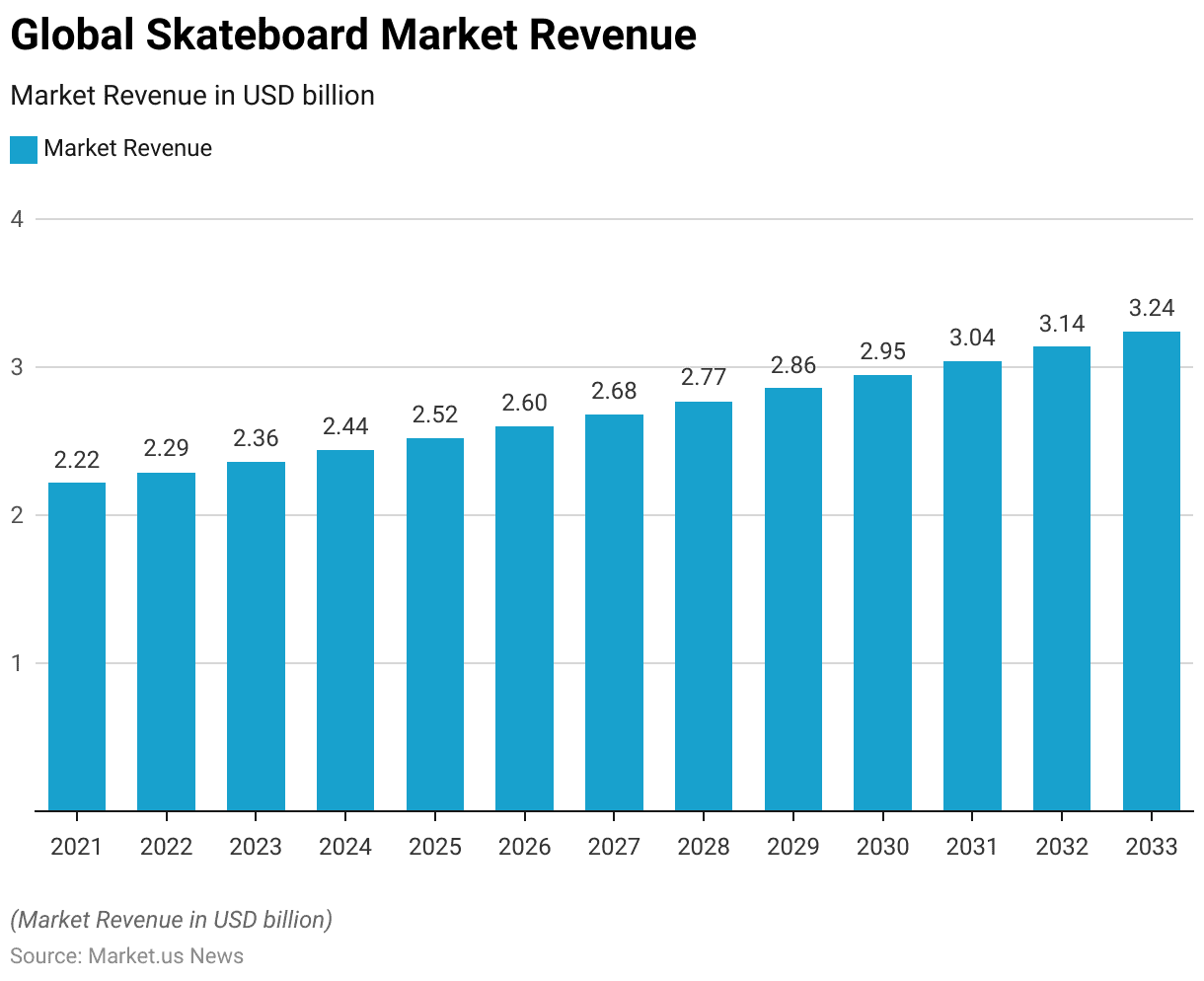
Competitive Landscape of the Global Skateboard Market
- The competitive landscape of the skateboard market is characterized by a diverse array of key players, each holding a significant market share.
- Element Skateboards leads the market with a 14% share. Closely followed by Krown Skateboards and Absolute Board, each commanding 12% of the market.
- SK8FACTORY holds an 11% share, while Alien Workshop and Artprint account for 10% and 9% of the market, respectively.
- Zero Skateboards has an 8% market share, and Control Skateboards holds a 7% share.
- Collectively, other key players in the market constitute 17%. Highlighting the presence of numerous influential brands contributing to the market’s overall dynamics.
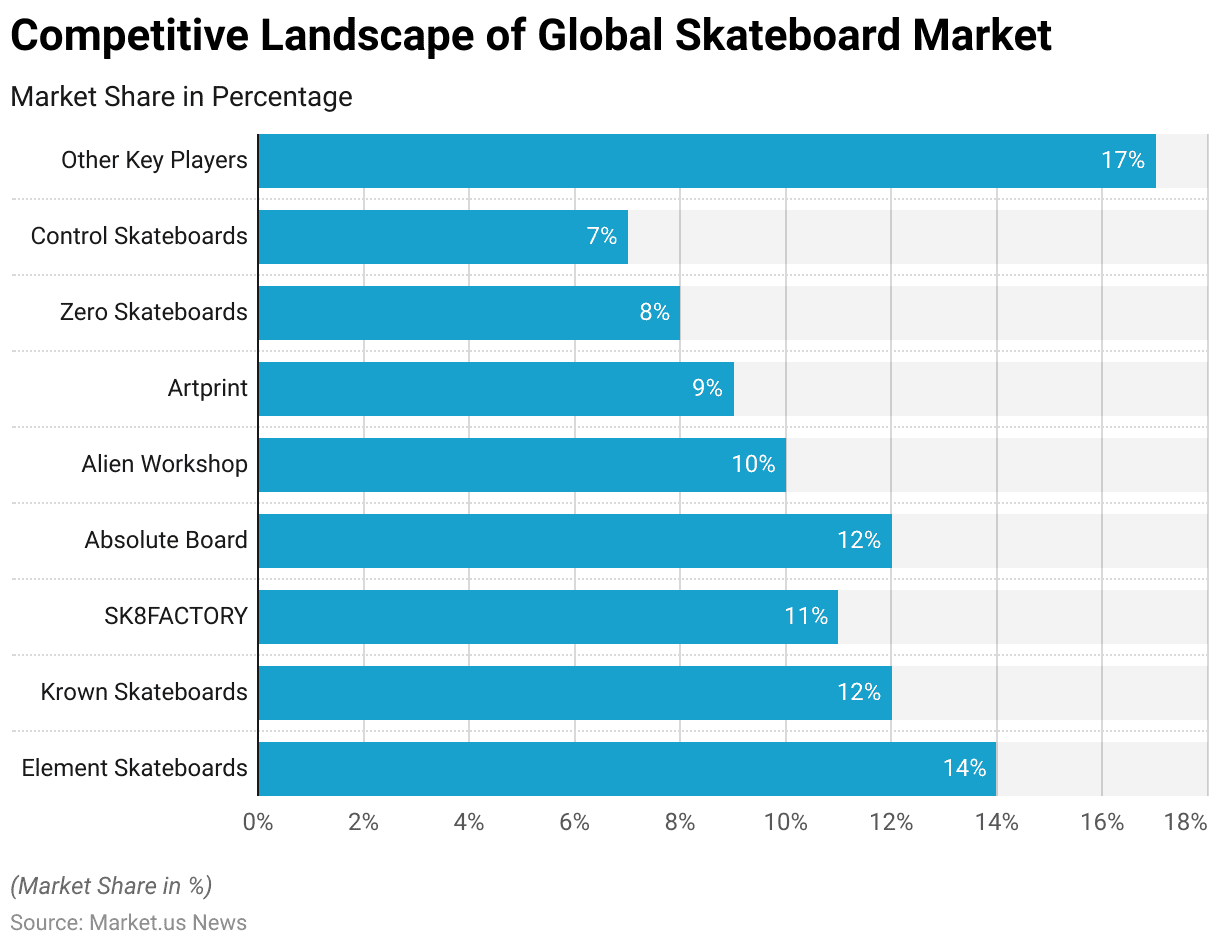
Regional Analysis of the Global Skateboard Market
- The global skateboard market is distributed across various regions, each contributing significantly to the overall market dynamics.
- North America holds the largest share, accounting for 33.7% of the market. Driven by a strong skateboarding culture and established industry presence.
- The Asia-Pacific (APAC) region follows closely with a 30.2% share, reflecting rapid growth and increasing popularity of the sport.
- Europe contributes 24.3% to the market, supported by a robust skateboarding community and infrastructure.
- South America, the Middle East, and Africa (MEA) regions, while smaller in comparison, account for 7.6% and 4.2% of the market, respectively. Indicating emerging interest and potential for future growth in these areas.
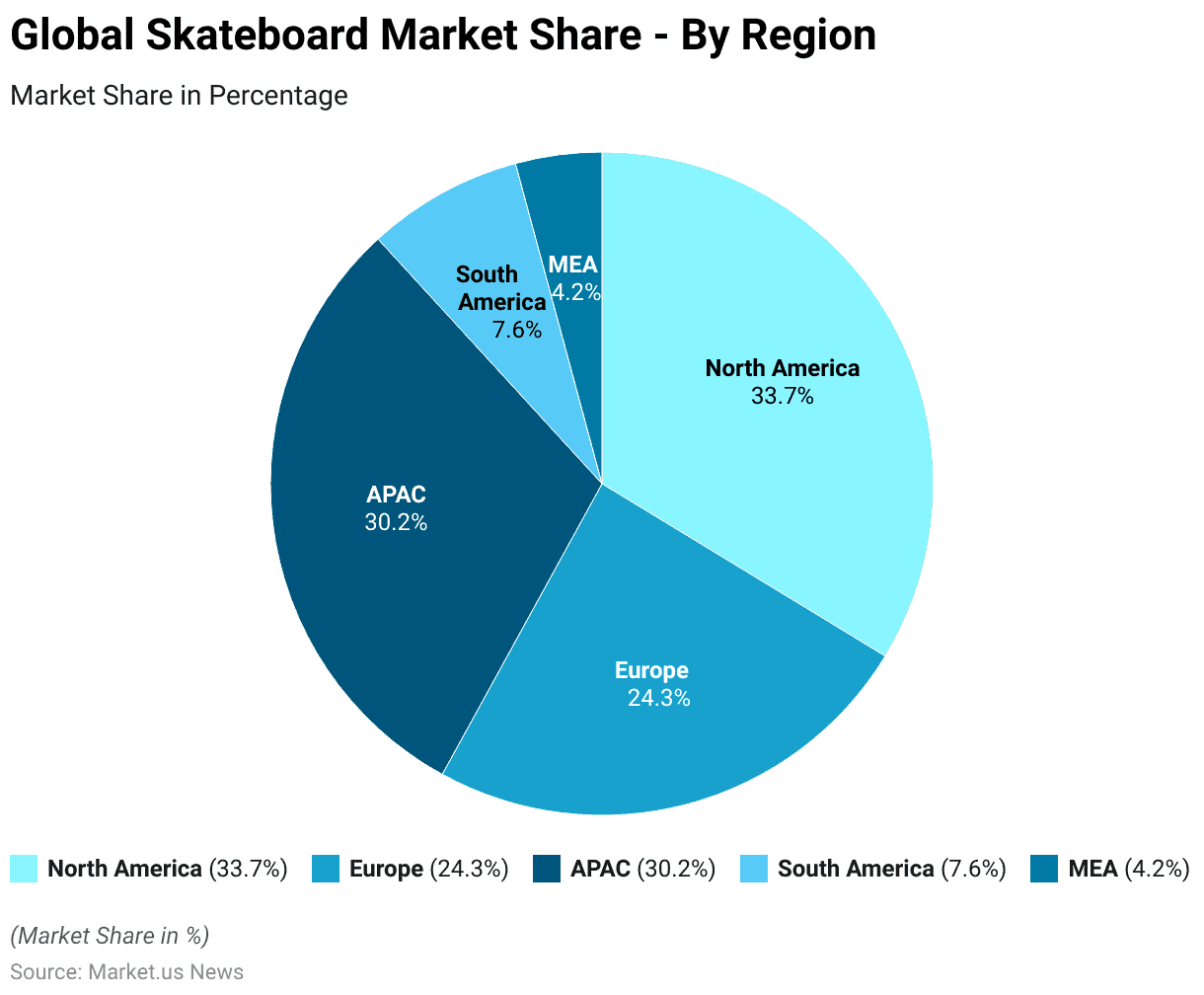
Skateboard Export Statistics
- In 2022, the global export market for ice skates, roller skates, and skating boots was dominated by China, which accounted for a significant 59.9% of the total export value, amounting to USD 600 million.
- Vietnam followed distantly, with exports valued at USD 54 million, representing 5.39% of the market.
- Italy held a 4.13% share with exports worth USD 41.3 million, while Thailand and Germany contributed USD 34.7 million and USD 33.6 million, corresponding to 3.47% and 3.35% of the market, respectively.
- France exported USD 31.7 million worth of these products, capturing a 3.17% share.
- Canada and Sweden each held modest shares of 2.45% and 2.37%, with export values of USD 24.6 million and USD 23.7 million, respectively.
- Cambodia contributed USD 20.3 million, or 2.03% of the market, followed by the United States with USD 18.1 million (1.8%) and Spain with USD 17.9 million (1.78%).
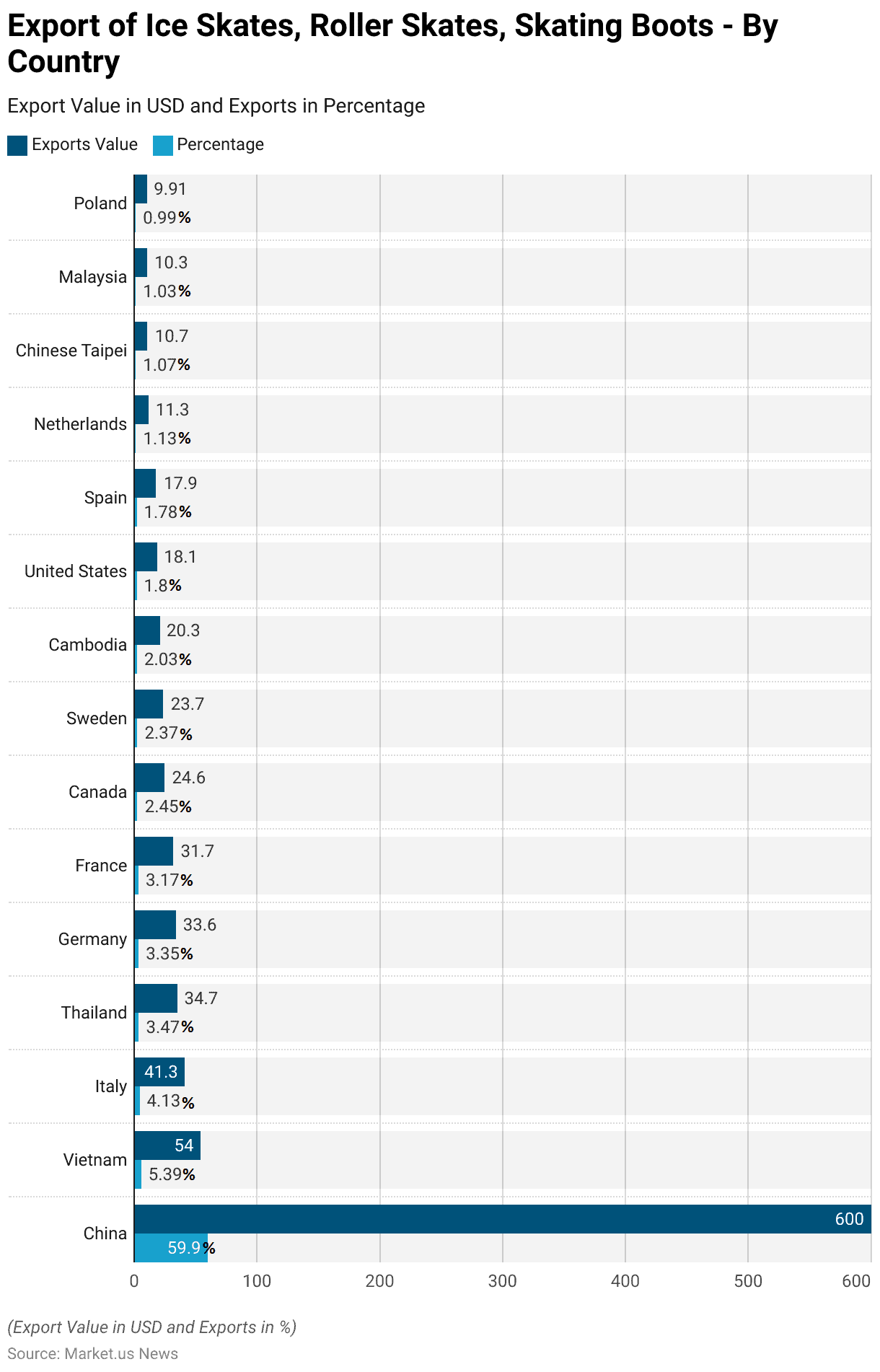
Skateboard Import Statistics
- In 2022, the United States emerged as the leading importer of ice skates, roller skates, and skating boots, with imports valued at USD 195 million, accounting for 19.4% of the global import market.
- Germany followed with an import value of USD 88.1 million, representing 8.8% of the market.
- Canada imported USD 81.7 million worth of these products, capturing an 8.15% share.
- France and Poland also had significant shares, importing USD 49.7 million (4.96%) and USD 46.9 million (4.68%), respectively.
- Italy’s imports were valued at USD 41.6 million, constituting 4.15% of the market, while the
- Netherlands and Russia imported USD 34.2 million (3.41%) and USD 33 million (3.29%), respectively.
- Spain followed closely with imports worth USD 31.3 million, accounting for 3.12% of the market.
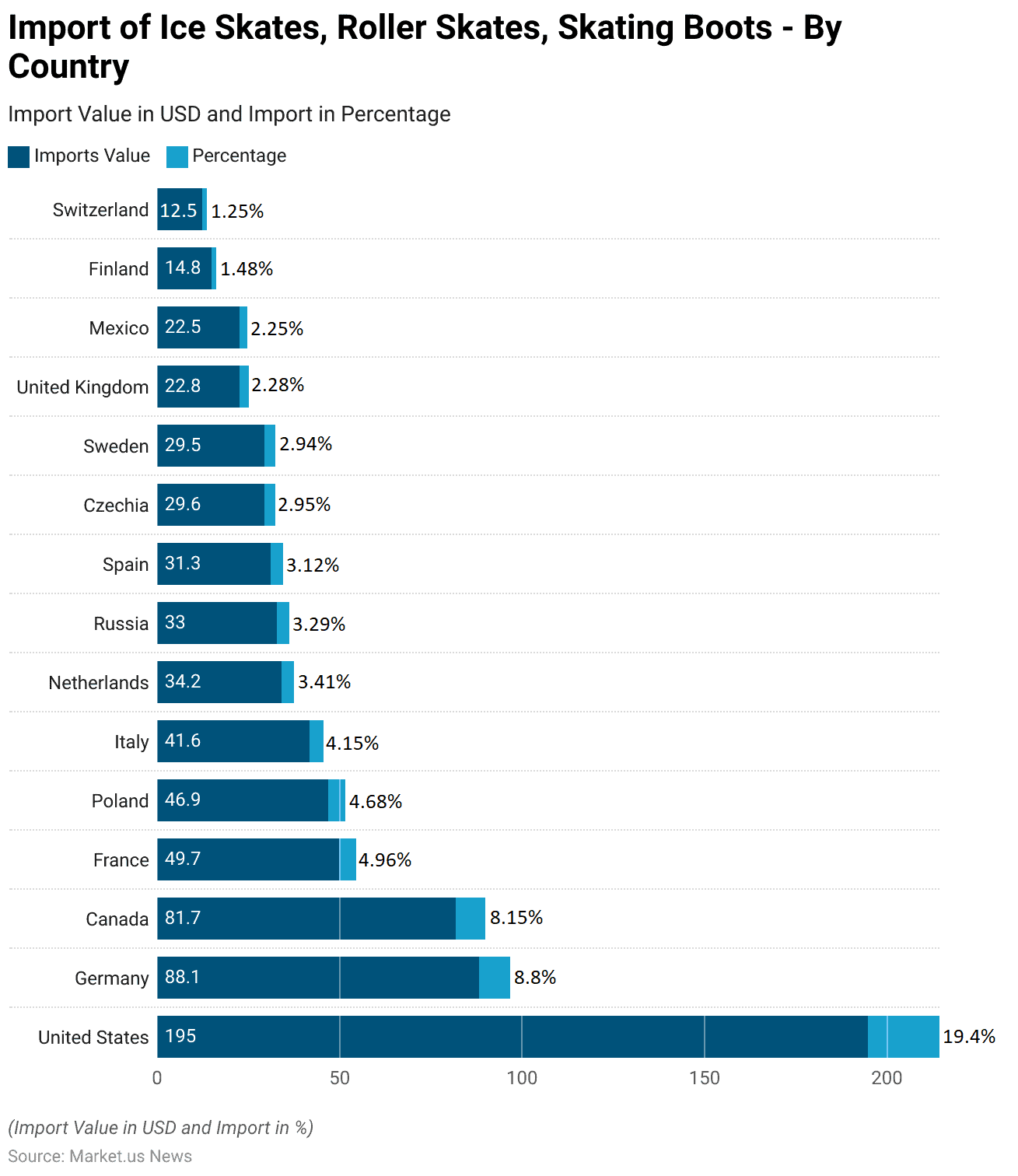
The Popularity of Skateboarding in the United States
Skateboarding Participation in the United States
- The number of skateboarding participants in the United States has exhibited fluctuating trends from 2010 to 2023.
- In 2010, the skateboarding population was recorded at 7.08 million.
- A significant surge occurred in 2020, with the skateboarding population reaching 8.87 million, likely influenced by increased interest in outdoor activities during the COVID-19 pandemic.
- Although there was a slight decrease to 8.75 million in 2021, the number of participants grew again to 9.02 million in 2022.
- In 2023, the participation rate slightly decreased to 8.92 million.
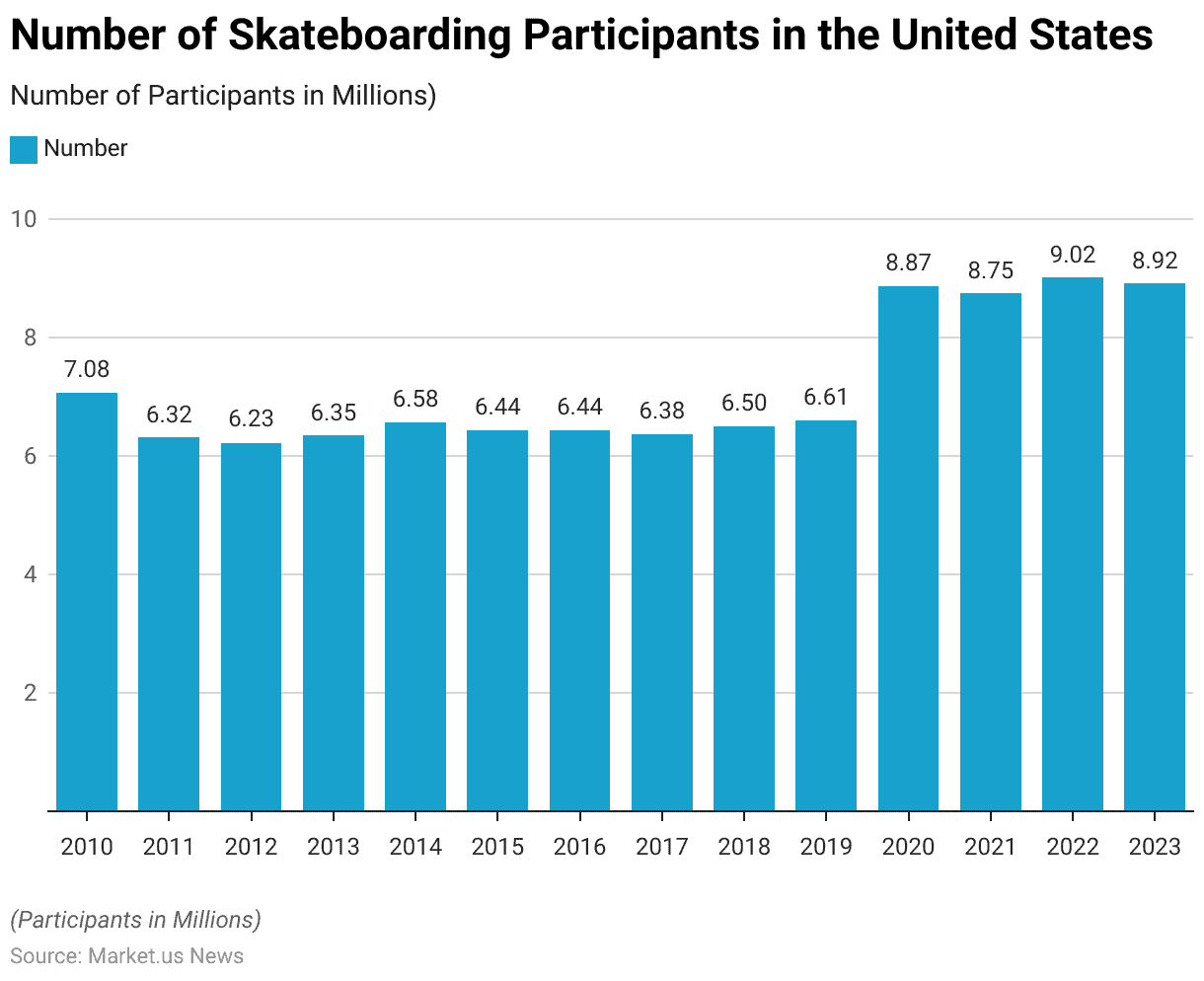
Demographics of Skateboarding Participants
Race and Ethnicity of Skaters
- The self-identified race and ethnicity of skaters reveal a diverse community.
- LatinX individuals, encompassing Hispanic, Latino, and Spanish heritage, constitute the largest group at 36%.
- Those who identify with more than one race or ethnicity follow closely, representing 33% of the skating population.
- Asian/Pacific Islanders account for 11%, while individuals of African descent, including Black, African American, and Afro-Caribbean skaters, make up 10%.
- An additional 7% of skaters fall under the “Other” category, and 3% identify as Indian or Alaska Native.
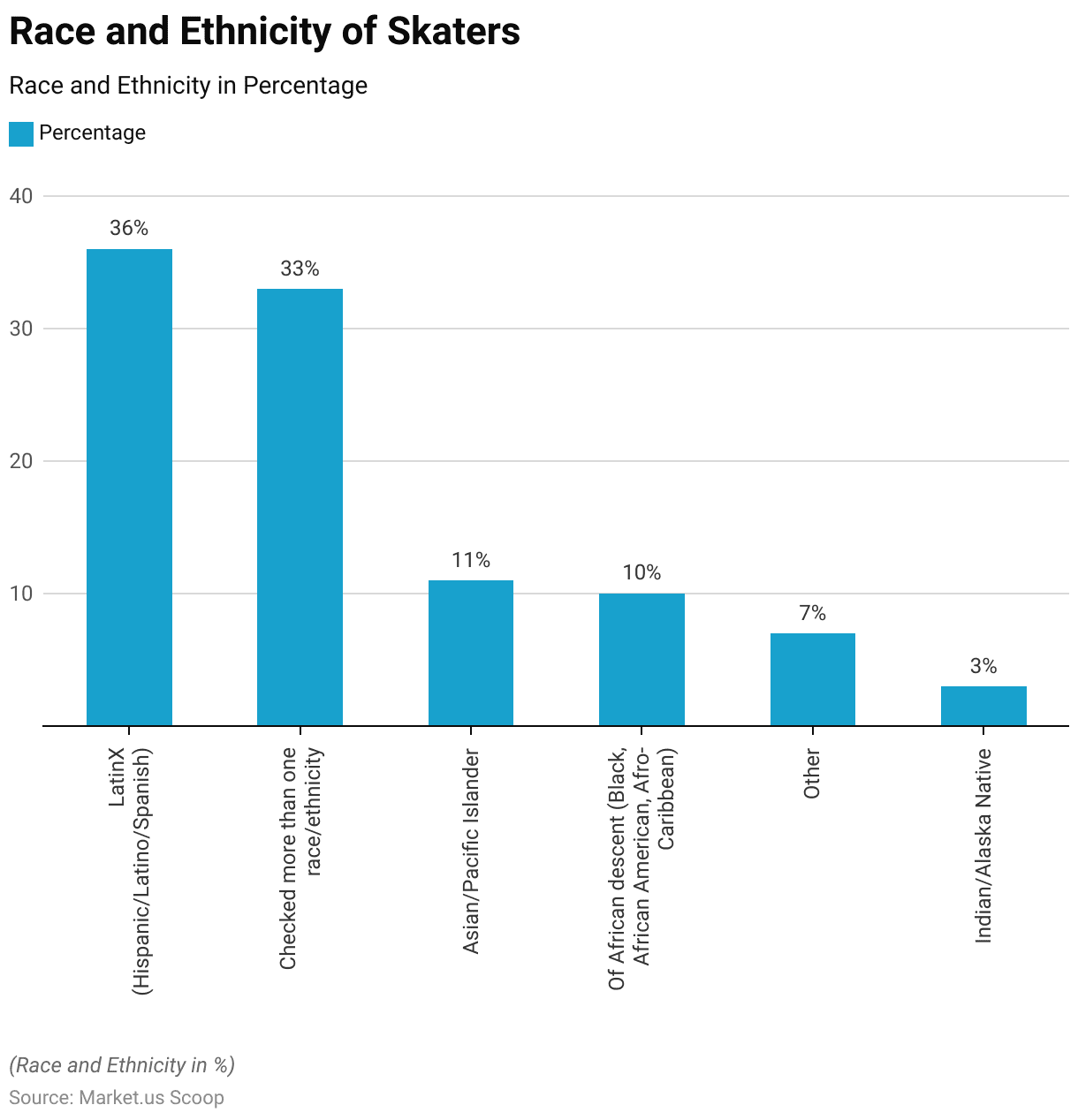
Gender Distribution
- A study conducted in 2010 found that 8.6% of American teenagers had tried skateboarding, and 1.7% of those under 18 were regular skateboarders.
- It was also noted that 77.1% of skaters were male, with males comprising 83.4% of regular, or ‘core,’ skaters.
- Conversely, 23.9% of skaters were female, and only 16.6% of core skaters were female.
- However, recent trends indicate a significant increase in female participation in skateboarding. According to a March 2023 report by GOSKATE, women now make up 40% of all skateboarders.
Motivations for Skateboarding
- A survey on the reasons why individuals skateboard revealed a variety of motivations among respondents.
- The majority, 76%, cited having fun as their primary reason for skateboarding.
- Additionally, 62% use skateboarding as a way to get away from stress, while 58% are motivated by the desire to learn tricks.
- For 57% of respondents, skateboarding serves as a medium to be creative and express themselves.
- Meeting up with friends was a key reason for 53% of the participants, and 52% skateboard for exercise.
- A smaller percentage, 37%, use skateboarding as a mode of transportation, and 26% skateboard to spend time alone.
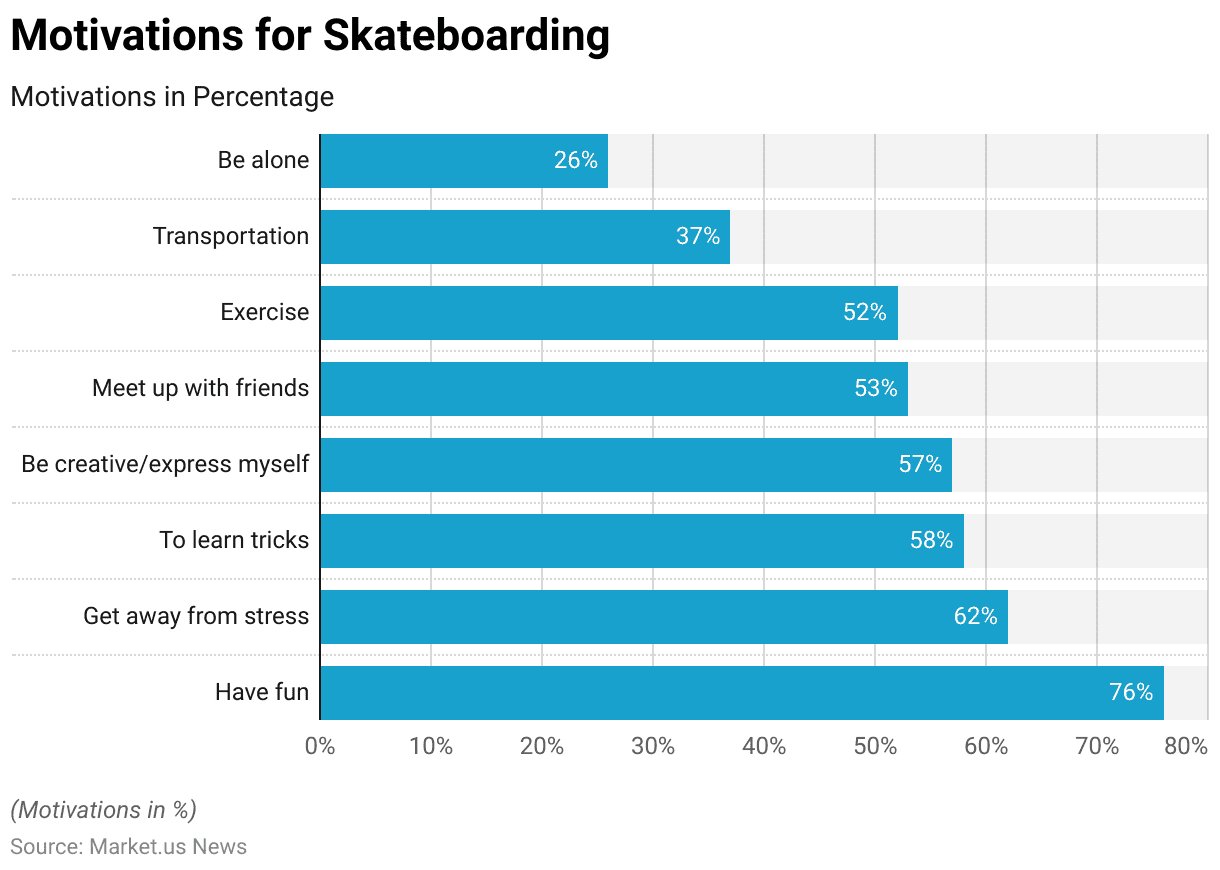
Skateboarders’ Top Concerns
- A survey of skateboarders under the age of 26 revealed various concerns across different demographic groups.
- Financial issues were the top concern for all groups, with 74% of all skaters, 68% of female skaters, and 68% of skaters of color indicating this as a primary concern.
- Finding a job was also significant, cited by 45% of all skaters and 41% of both female skaters and skaters of color.
- Disrespect, negativity, and hate were concerns for 44% of all skaters, with a slightly higher concern among female skaters (46%) and lower among skaters of color (36%).
- Daily responsibilities were a concern for 41% of all skaters, 39% of female skaters, and 33% of skaters of color.
- College admission worries were noted by 24% of all skaters, 28% of female skaters, and 26% of skaters of color.
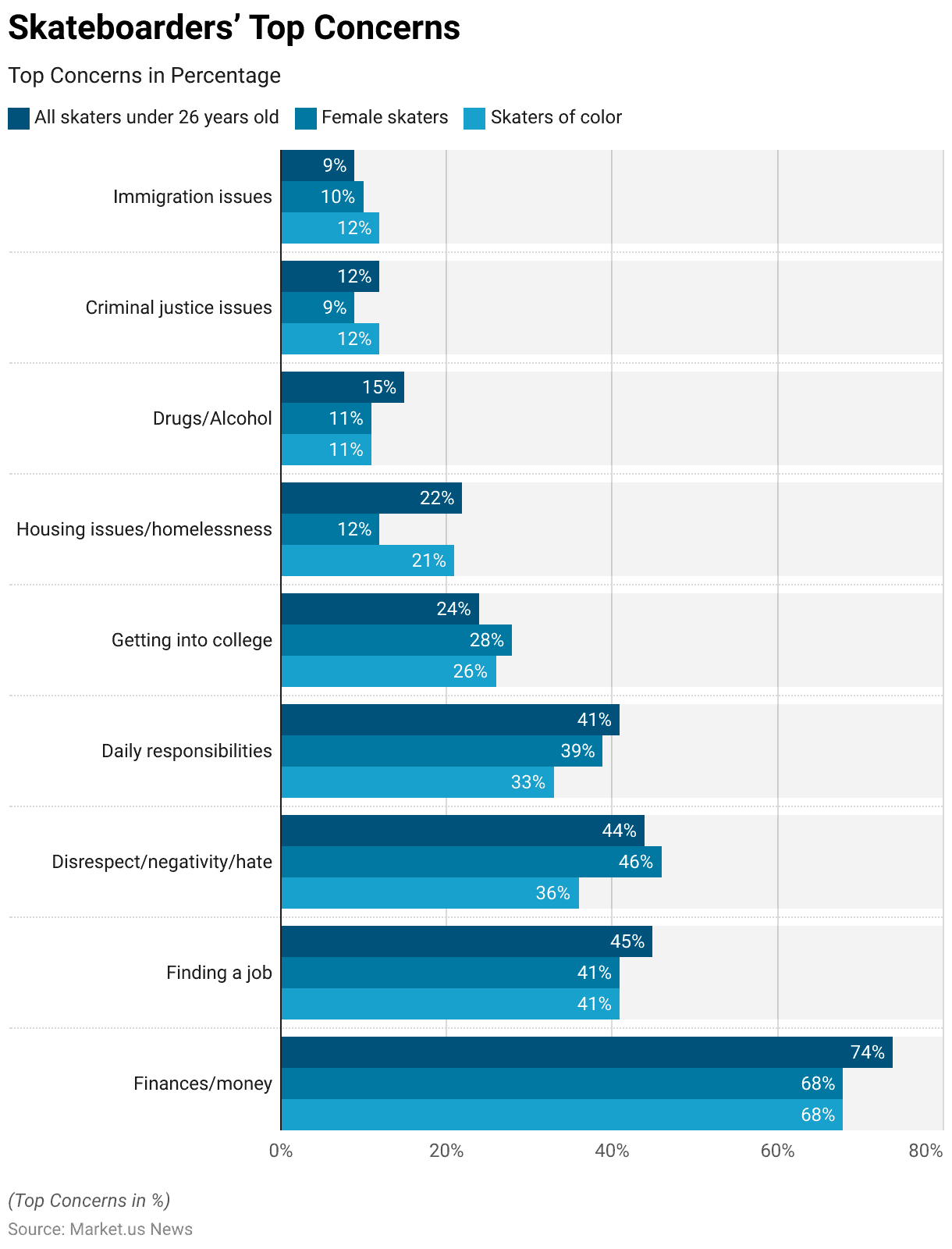
Regulations for Skateboarding
- Skateboarding regulations vary significantly by country, reflecting local priorities on safety and public order.
- In the United States, skateboarding laws are typically set by municipalities and include mandates on helmet use, restrictions on where skateboards can be ridden (e.g., prohibitions on public streets in certain cities), and age requirements.
- For instance, in California, skateboarders under 18 are required to wear helmets, and skateboarding on public streets is largely restricted.
- In Japan, skateboarding is generally limited to designated skate parks, and helmet use is strongly recommended, though not always mandated. As skateboarding becomes more popular globally, electric skateboards are also seeing specific regulations.
- These include speed limits typically set between 20-25 km/h, mandatory helmet use, and sometimes requirements for registration and insurance.
Discuss Your Needs With Our Analyst
Please share your requirements with more details so our analyst can check if they can solve your problem(s)





